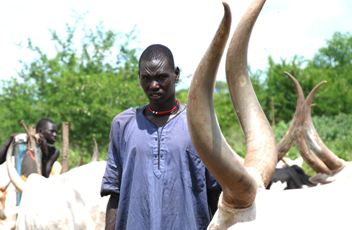FAO, gov’t conduct livestock vaccination in S. Sudan
By Julius N. Uma
September 29, 2011 (TEREKEKA) A team of technical experts from UN Food and Agricultural Organization (FAO) and officials from the ministry for animal resources and fisheries on Thursday successfully conducted a one-day livestock vaccination exercise in Terekeka county, Central Equatoria state.

A group of male pastoralists, majority of them dressed half-tied clothes inquisitively stared at the visiting team as they stormed the cattle camp, while naked children occasionally played around, perhaps in excitement.
Khamis John Konga, the county’s vertinary assistant commissioner told Sudan Tribune that animal in the cattle camp, which houses approximately 1,200 has, in the recent past, been prone to different bacterial infections.
“Our pastoralists have lost so many cattle in the past. However, we feel this Bovine Pastuerellosis and black leg vaccines being administered today will make these animals resistant to any bacterial infection,” Konga said.
George Okech, FAO’s head of office, who accompanied the team, also underscored the importance of the livestock sector in the various South Sudan communities. Reduction in livestock, he said, will threaten food security, disrupt normal livelihood and interfere with society cultural norms.
FAO, Okech reiterated, remains committed towards providing technical support to the livestock industry, describing it as one of the mechanisms for reducing the widespread inter-communal conflicts, most of which are seen as cattle-related.
Albeit the exact livestock population in Africa’s newest nation still remains unknown to-date, FAO and the southern government estimates put it at 11 and 19 million cattle and small (sheep and goats) respectively. This year alone, FAO has reportedly given out about three million doses of vaccines targeting various livestock infections.
Erina Sake, a teenage girl at the cattle camp said she was relieved by the presence of the vaccination team, but urged the southern government to provide continuous assistance towards saving more cattle lives in Terekeka.
“We have lost very many cattle and yet this is our source of living. We request the government to visit us regularly to access the conditions of our cattle,” Sake, speaking through a translator, said.
In recent years, South Sudan has been prone livestock disease outbreaks, often requiring immediate response. In March this year, for instance, the World Health Organization (WHO) reported nearly 90 suspected cases of Anthrax, while another reported case of rift valley fever was put under control.
Officials from FAO, however, maintain that livestock risks from the deadly rift valley fever remain high, especially in the absence of a robust surveillance system.
Although FAO estimate 5 million animals to be vaccinated by the end of 2011 alone, at least 3.8 million have reportedly undergone the process. The organization, however, cited inadequate funding, lack of trained personnel, inadequate vaccines, poor infrastructure and insecurity as some of the setbacks to vaccination exercise.
(ST)
